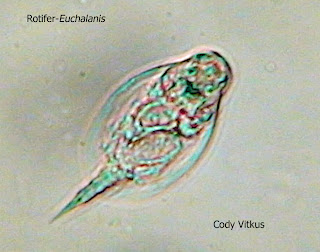Botany 111
Tuesday, November 15, 2011
Week 4 Observations: Nov. 7th-11th
This week I made my final observations of my micro-aquarium. The first thing I noticed was how far down my water level had gotten. It was nearly two-thirds of the way down since filling it to the top the previous week! I did not notice any new organisms this week, however it did seem that the population of Rotifers in my micro-aquarium had gone down significantly. I have not yet come up with a theory as to why there was such a drastic decline in the population of these certain organisms. I also observed a few new Cyclops that appeared to be in the beginning stages of development as well as more that had fully developed. I was unable to obtain a picture of the aquatic earthworm this week unfortunately because it refused to come out of the soil and therefore I was not able to get a clear shot of it. All in all, I think this was a good project and I am glad I was able see how micro-organisms live in their habitat.
Tuesday, November 8, 2011
Week 3 Observations: Oct. 31st - Nov. 4th
This week I observed one new organism in my micro-aquarium that I had not observed in the previous weeks. I identified this organism to be Oligochaeta (Smith 2001). Oligochaeta is described as an aquatic earthworm. Under the microscope, it looks similar to the earthworms we see in soils. There was only one of these organisms that I noticed while I was observing the aquarium and it tended to stay close to the plant life in the aquarium. During my observation I also noticed a much larger abundance of Rotifers and Cyclops than prior weeks. The Cyclops appeared to be at a much higher maturity level as well, appearing to be fully developed. The water level in my aquarium was down to about halfway so I filled it back up to the top. I hope to obtain some pictures during my final observation next week to show the development of the lifeforms as well as to show the aquatic earthworm.
Works Cited:
Smith, Douglas Grant. Pennak's Freshwater Invertebrates of the United States. 4th ed. 2001. John Wiley & Sons, Inc. New York. pp 276
Works Cited:
Smith, Douglas Grant. Pennak's Freshwater Invertebrates of the United States. 4th ed. 2001. John Wiley & Sons, Inc. New York. pp 276
Tuesday, November 1, 2011
Week 2 Observations: Oct. 24th-28th
Rainis (p.231)
Rainis (p.231)
Rainis (p.231)
Desmid--Smith (2001)
Rainis (p.207)
Rainis (p.207)
The above images show some of the lifeforms I observed this week in my aquarium. The first three are images of the Cyclops, the third image being a Cyclops Naupliss which is simply a Cyclops that has not fully developed yet. The second image shows three of these Cyclops, each in a different stage of development. The fourth image is a Desmid, which is a type of algae. It is in the Protista kingdom. The fifth and sixth images show the Rotifer Euchlanis. The Rotifers are by far the most abundant lifeforms in my aquarium to date. On another note, on October 21, 2011 one Beta Food Pellet was added to the micro-aquarium. The information on this food is as follows:
"Atison's Betta Food" made by Ocean Nutrition, Aqua Pet Americas, 3528 West 500 South, Salt Lake City, UT 84104. Ingredients: Fish meal, wheat flower, soy meal, krill meal, minerals, vitamins and preservatives. Analysis: Crude Protein 36%; Crude fat 4.5%; Crude Fiber 3.5%; Moisture 8% and Ash 15%.
It should be interesting to see the significance this will have on the number of lifeforms that arise in the following weeks.
Week 1 Observations: Oct. 17th-21st
After one week of setting up my micro-aquarium, I noticed significant signs of life in the ecosystem. The two main organisms I observed under the microscope were identified as Rotifers Euchlanis (Rainis 207) and Cyclops (Rainis 231). The Rotifers looked like tiny fish that just seemed to swim around, mostly staying close to the plant life within the aquarium. The Cyclops on the other hand appeared to be a relative of the Crustaceans. The Cyclops were much bigger than the other life in the aquarium and tended to stay in the soil at the bottom of the aquarium or very close to it. It was very interesting to observe this micro-life and I am looking forward to seeing what else pops up in the coming weeks.
Works Cited:
Rainis, K.; Russell, B. 1996. Guide to Microlife. Danbury, Connecticut: Groiler Publishing pg. 207
Works Cited:
Rainis, K.; Russell, B. 1996. Guide to Microlife. Danbury, Connecticut: Groiler Publishing pg. 207
Sunday, October 23, 2011
Aquarium Set-up and Water Source
Aquarium set-up

9. Pond at Sterchi Hills Greenway Trail. Rife Range Rd. Knox Co. Knoxville TN Full sun exposure. Sheet runoff N36 02.687 W83 57.159 1065 ft 10/9/2011
- We assembled a small micro-aquarium and then drew water from one of the thirteen souces with a pipette and emptied the water into the aquarium.
- Next we placed a small amount of soil into the aquarium and let it settle to the bottom.
- Then we placed 2 different types of plants into the aquarium. The names of these plants are:
- Amblestegium (moss)
- Utricularia gibba (carnivorous plant)
- Observed aquarium and placed in the lab room
9. Pond at Sterchi Hills Greenway Trail.

9. Pond at Sterchi Hills Greenway Trail. Rife Range Rd. Knox Co. Knoxville TN Full sun exposure. Sheet runoff N36 02.687 W83 57.159 1065 ft 10/9/2011
Subscribe to:
Posts (Atom)





